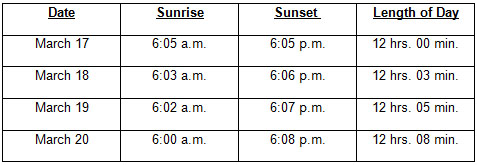Spring Arrives With Equinox Tuesday, Earliest in Over a Century

Across much of the United States, this has been an unusually mild winter, especially for those living east of the Mississippi. Not a few people have noted that spring seems to have come early this year. Of course, in a meteorological sense that could be true, but in 2012 it will also be true in an astronomical sense as well, because this year spring will make its earliest arrival since the late 19th century: 1896, to be exact.
The vernal equinox — the first day of spring — will arrive tomorrow (March 20) at 05:14 Universal Time, or 1:14 a.m. EDT. Even more intriguing is that for those in the Mountain and Pacific Time zones, the equinox will actually arrive tonight (March 19).
Astronomers define an equinox as that moment when the sun arrives at one of two intersection points of the ecliptic (the sun's path across the sky) and the celestial equator (Earth's equator projected onto the sky). One such intersection point is located in western Virgo; the sun arrives there on Sept. 22 or 23, and appears to cross the equator from north to south, marking the beginning of autumn in the Northern Hemisphere.
The other intersection point, in eastern Pisces, is where the sun will be tomorrow. The sun is now migrating north of the equator, hence this is the "vernal" or spring equinox. At 5:14 UT next Tuesday, the sun will be shining directly over the equator from the point of view of a spot in the Indian Ocean, 757 miles (1,218 km) southeast of Colombo, Sri Lanka. [Earth's Equinoxes & Solstices (Infographic)]
Why so early?
Now maybe this rings false. After all, when some of us of a certain age were growing up, the first day of spring was always on March 21, not March 20, right? Now all of a sudden spring is coming on March 20, and as we just noted, even earlier — March 19 — for some.
Is this unheard of? Not if you look at the statistics. In fact, did you know that during the 20th century, March 21 was actually the exception rather than the rule? The vernal equinox landed on March 21 only 36 out of 100 years — most of these occasions coming during the early and middle part of the 20th century. Yet from 1981 to 2102, Americans celebrate the beginning of spring no later than March 20. Still, for many March 21 is ingrained in our culture as the traditional first day of spring, even though it's been more than 30 years since that last happened.
Sign up for the Live Science daily newsletter now
Get the world’s most fascinating discoveries delivered straight to your inbox.
There are a few reasons why seasonal dates can vary from year to year.
- A year is not an even number of days, and neither are the seasons. To try to achieve a value as close as possible to the exact length of the year, our Gregorian Calendar was constructed to give a close approximation to the tropical year, which is the actual length of time it takes for Earth to complete one orbit around the sun. It eliminates leap days in century years not evenly divisible by 400, such 1700, 1800 and 2100, and millennium years that are divisible by 4000, such as 8000 and 12000.
- Another reason is that Earth's elliptical orbit is changing its orientation relative to the sun (it skews), which causes Earth's axis to constantly point in a different direction, called precession. Since the seasons are defined as beginning at strict 90-degree intervals, these positional changes affect the time Earth reaches each 90-degree location in its orbit around the sun.
- The pull of gravity from the other planets also affects the location of Earth in its orbit.
The current seasonal lengths for 2012 in the Northern Hemisphere are:
Winter: 88.994 days Spring: 92.758 days Summer: 93.651 days Autumn: 89.842
The warm seasons of spring and summer combined are 7.573 days longer than the colder seasons, fall and winter (good news for warm weather admirers). However, spring is currently being reduced by approximately one minute per year and winter by about half a minute per year.
Summer is gaining the minute lost from spring, and autumn is gaining the half-minute lost from winter. Winter is the shortest astronomical season, and with its seasonal duration continuing to decrease, it is expected to attain its minimum value — 88.71 days — by about the year 3500.
Not equal on the equinox
Another complication revolving around the vernal equinox concerns the length of day versus night. We have been taught that on the first days of spring and autumn, the day and night are equal to exactly 12 hours all over the world. Yet, if you check the calculations made by the U.S. Naval Observatory or the sunrise/sunset tables in any reputable almanac, you will find that this is not so. In fact, on the days of the spring and fall equinox, the length of daylight is actually longer than darkness by several minutes.
Take the case of New York City, for example. As the table below shows, days and nights are equal not on the equinox, but on Saint Patrick's Day.

One factor is that the moments of sunrise and sunset are considered to be when the top of the sun, and not its center, is on the horizon. This fact alone would make the time of sunrise and sunset a little more than 12 hours apart on these days. The sun's apparent diameter is about equal to half a degree.
But the main reason that this happens can be attributed to our atmosphere, which acts like a lens and refracts (bends) the sun's light above the edge of the horizon.
In its calculations of sunrise and sunset times, the U.S. Naval Observatory routinely uses 34 minutes of arc for the angle of refraction and 16 minutes of arc for the semidiameter of the sun's disc. In other words, the geometric center of the sun is actually 0.83 degrees below a flat and unobstructed horizon at the moment of sunrise.
Or, put in another way, when you watch the sun either coming up above the horizon at sunrise or going down below the horizon at sunset, you are actually looking at an illusion — the sun is not really there, but is actually below the horizon!
As a result, we end up seeing the sun for a few minutes before its disk actually rises and for a few minutes after it has truly set. Thus, thanks to atmospheric refraction, the length of daylight on any given day is increased by approximately six or seven minutes.
Other parts of the world
For Europe, spring began on March 21 in the year 2007. That, however, was the last time until 2102.
For places much farther to the east, such as Tokyo (nine hours ahead of Greenwich, England), spring will fall on March 21 in two out of every four years from 2014 through 2023 (2014, 2015, 2018, 2019, etc.), and then once every four years from 2027 through 2055. But then that's it until 2101.
This story was provided by SPACE.com, a sister site to LiveScience. Joe Rao serves as an instructor and guest lecturer at New York's Hayden Planetarium. He writes about astronomy for The New York Times and other publications, and he is also an on-camera meteorologist for News 12 Westchester, New York.











